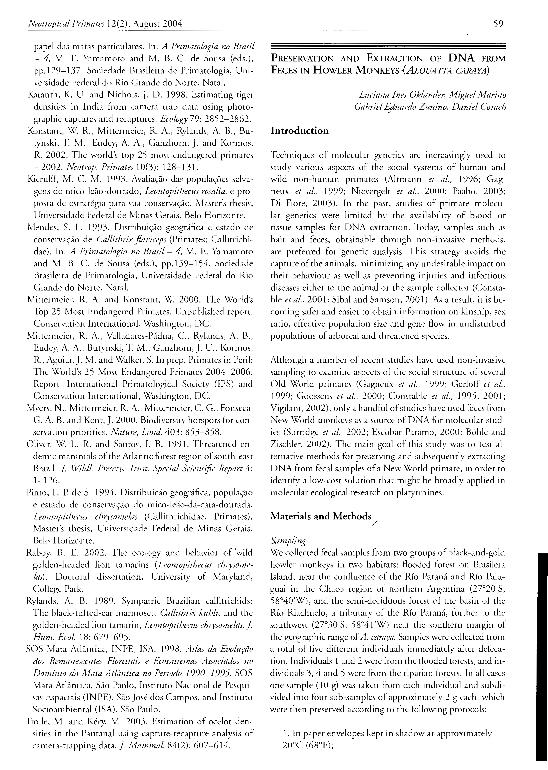Artículo
Preservation and Extration of DNA from Feces in Howler Monkeys (Aluatta caraya)
Fecha de publicación:
08/2004
Editorial:
BioOne
Revista:
Neotropical Primates
ISSN:
1413-4705
Idioma:
Inglés
Tipo de recurso:
Artículo publicado
Clasificación temática:
Resumen
Techniques of molecular genetics are increasingly used tostudy various aspects of the social systems of human andwild non-human primates (Altmann et al., 1996; Gagneuxet al., 1999; Nievergelt et al., 2000; Paabo, 2003;Di Fiore, 2003). In the past, studies of primate moleculargenetics were limited by the availability of blood ortissue samples for DNA extraction. Today, samples such ashair and feces, obtainable through non-invasive methods,are preferred for genetic analysis. This strategy avoids thecapture of the animals, minimizing any undesirable impact ontheir behaviour as well as preventing injuries and infectiousdiseases either to the animal or the sample collector (Constableet al., 2001; Sibal and Samson, 2001). As a result, it is becomingsafer and easier to obtain information on kinship, sexratio, effective population size and gene flow in undisturbedpopulations of arboreal and threatened species.Although a number of recent studies have used non-invasivesampling to examine aspects of the social structure of severalOld World primates (Gagneux et al., 1999; Gerloff et al.,1999; Goossens et al., 2000; Constable et al., 1995, 2001;Vigilant, 2002), only a handful of studies have used feces fromNew World monkeys as a source of DNA for molecular studies(Surridge et al., 2002; Escobar-Paramo, 2000; Böhle andZischler, 2002). The main goal of this study was to test alternativemethods for preserving and subsequently extractingDNA from fecal samples of a New World primate, in order toidentify a low-cost solution that might be broadly applied inmolecular ecological research on platyrrhines.
Palabras clave:
DNA extraction
,
feces
,
DNA typing
,
Primates
Archivos asociados
Licencia
Identificadores
Colecciones
Articulos(CECOAL)
Articulos de CENTRO DE ECOLOGIA APLICADA DEL LITORAL (I)
Articulos de CENTRO DE ECOLOGIA APLICADA DEL LITORAL (I)
Articulos(IBS)
Articulos de INSTITUTO DE BIOLOGIA SUBTROPICAL
Articulos de INSTITUTO DE BIOLOGIA SUBTROPICAL
Articulos(OCA HOUSSAY)
Articulos de OFICINA DE COORDINACION ADMINISTRATIVA HOUSSAY
Articulos de OFICINA DE COORDINACION ADMINISTRATIVA HOUSSAY
Citación
Oklander, Luciana Inés; Marino, Miguel Eduardo; Zunino, Gabriel Eduardo; Corach, Daniel; Preservation and Extration of DNA from Feces in Howler Monkeys (Aluatta caraya); BioOne; Neotropical Primates; 12; 8-2004; 59-63
Compartir




